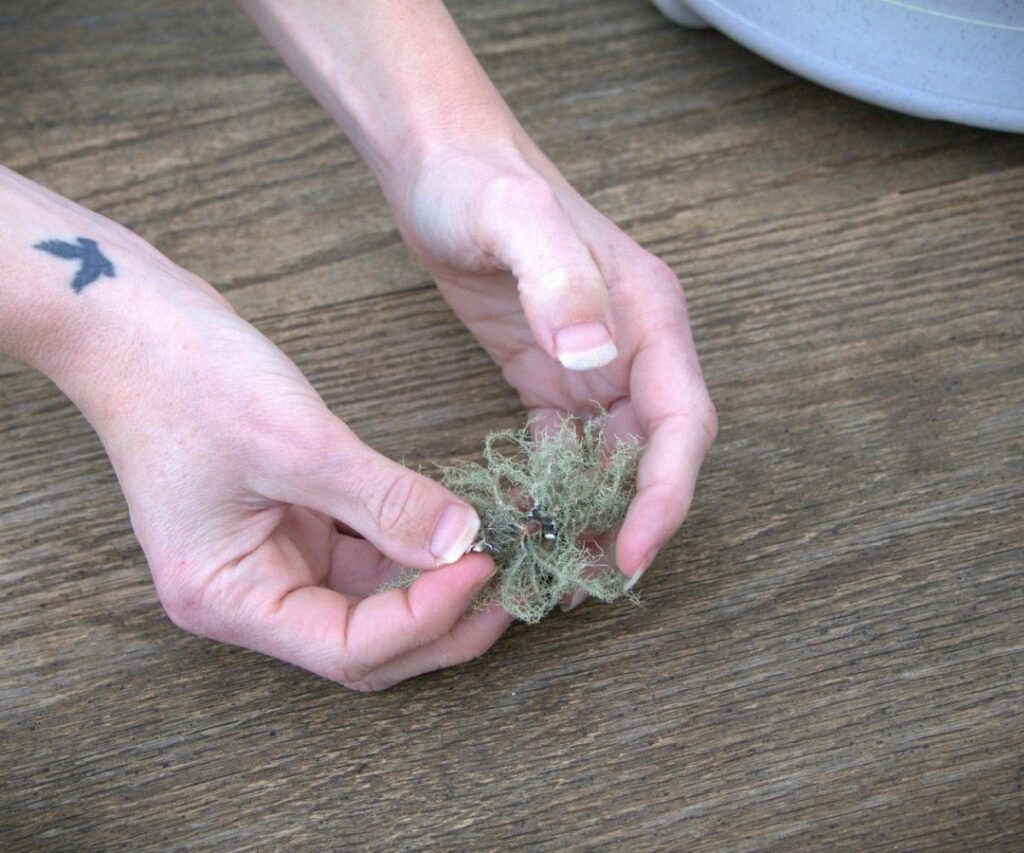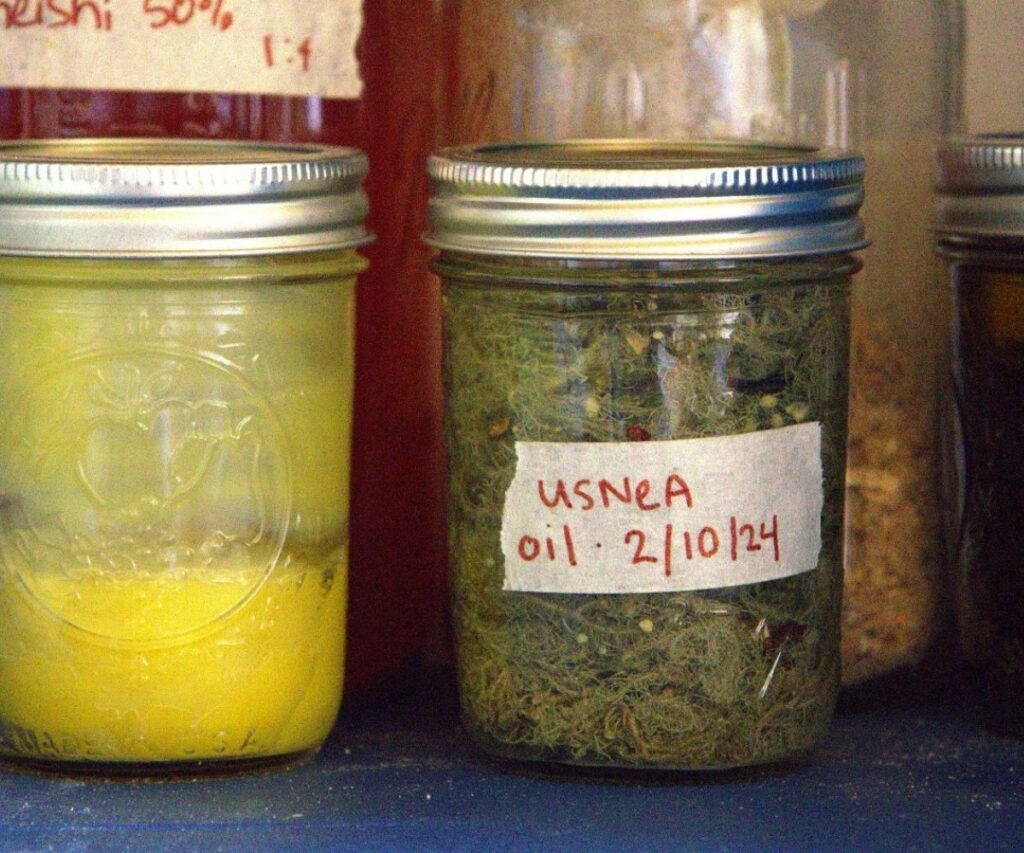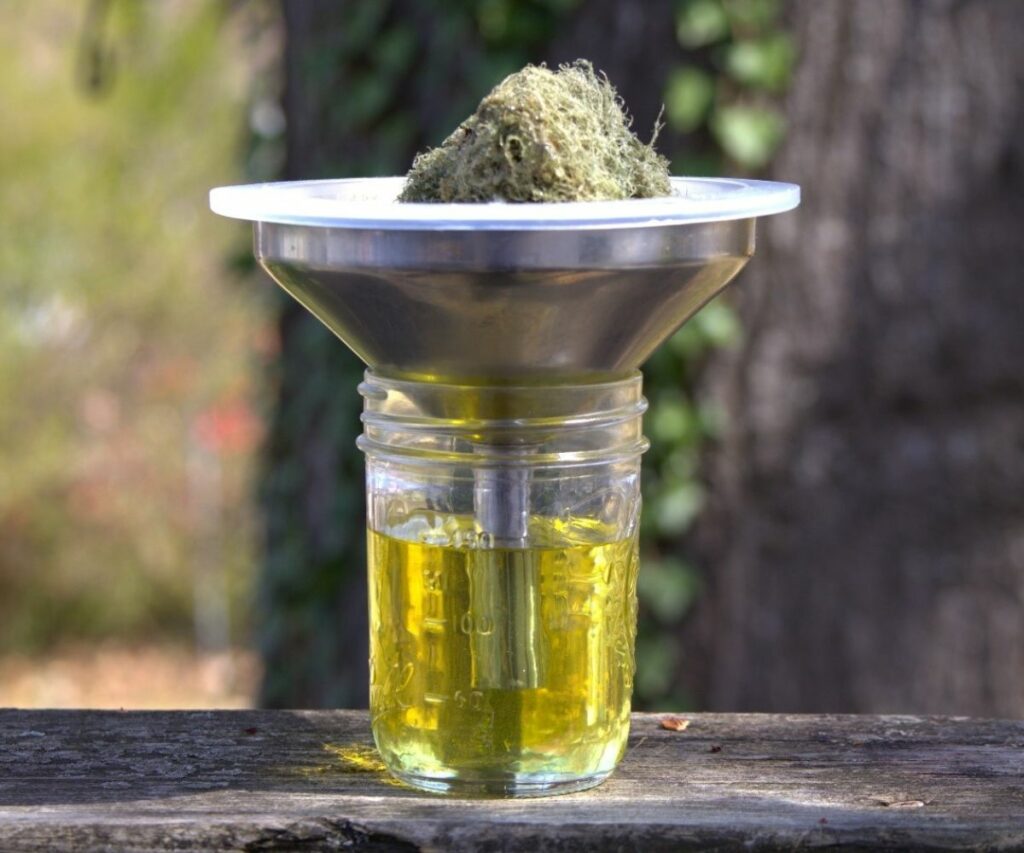Making usnea oil is easy, fun, and very beneficial for the homestead.
As an antimicrobial powerhouse, usnea provides the perfect base for DIY soaps and household cleaners. It’s great for cosmetics and skin-care products like salves, balms, lip treatments, and sunscreens.
You can take usnea oil internally as an alternative to an alcohol-based tincture. It’s also an interesting culinary oil, imbued with a subtle bitterness that goes well with sweet treats or fatty cuts of meat.
Ready to get creative? The possibilities are nearly endless. Read on to learn how to make usnea oil and let the experimentation begin!
Materials to Make Usnea Oil

Making usnea oil is very simple, with minimal hands-on prep time and a lot of waiting around. Here’s what you’ll need to get started:
- Usnea: Usnea serves as a soothing medicinal hero. You’ll need at least a few grams to start, but you can use more if you have it!
- Carrier oil: You’ll choose your carrier based on your desired application. You will need twice the amount of oil than you have of usnea.
- Mason jars: You’ll need one Mason jar to hold your oil as it’s infusing and another to strain it into once finished.
- Dehydrator (optional): Making usnea oil requires dry lichens. You can use a dehydrator or air-dry them.
- Scale (optional): You’ll weigh the usnea to determine the volume of oil you need. If you don’t have a scale, you can eyeball it.
- Amber glass (optional): If you’re making usnea oil to use as an internal medicine, it will last a while. Bottling it in amber will protect the oil’s integrity over time.
How to Make Usnea Oil
1. Source Usnea
If you live on a homestead or rural acreage, you should be able to forage usnea easily. This green, fruticose lichen has a wide range in the US and grows throughout the year.
If you live in a city or an area with poor air quality, it’s unlikely you’ll be able to gather it from nature. In that case, you can purchase usnea from a local herbalist or a reputable vendor online.

2. Clean Lichen
Usnea might be nicknamed “old man’s beard,” but it’s more like a goat’s beard — wiry, rough, and with an astounding propensity to trap even the tiniest speck of dirt.
Shake it out well to clean it. Unwrap its closed furls and brush off stubborn dirt and bark. Do not wash it in water; this will only prolong the drying process and could corrupt the finished usnea oil.

3. Dehydrate
Usnea is very dry already, so dehydrating doesn’t take long. I use a dehydrator set at 130 °F for about an hour.
What if you don’t have a dehydrator? You can just leave the lichen in a sunny place for about a day, and it should be dry enough to work with.

4. Weigh and Jar
Once your usnea is dry, weigh it and pack it into the bottom of a Mason jar. You will use the weight measurement to determine how much oil you need.
If you don’t have a scale, don’t sweat it. You can eyeball this one!

5. Add Oil
Double the weight of your usnea to figure out your liquid volume. For example, I’m using about half an ounce of usnea. Doubling that yields one ounce, so I add one ounce of oil.
Here’s a math equation you can use:
(Usnea weight X 2) = oil volume
If you aren’t using a scale, just pack the usnea firmly and add about twice as much oil to the jar.
This is a 1:2 ratio of dry herb to solvent, which is much stronger than I’d recommend for an alcohol-based tincture. I believe this ratio is ideal for several reasons.
The first is that when making usnea oil, we usually combine it with other ingredients to create products like salves or soaps. This dilutes the medicine considerably, so beginning with a strong base is necessary to make the end product potent.
The second is that I like to combine usnea oil with oregano oil to make salad dressings.
I find the bitter, earthy flavor profile goes nicely with fruity apple or pear salads, and to get that sort of flavor, you need to make a more potent infusion.
What oil is best? It depends on your desired use.
Don’t fall into the trap of thinking you need to go out and buy organic, premium-priced carriers to make usnea oil. You can always use what you have on hand in the kitchen.
Are you infusing oil for cooking? A neutral oil like canola or rapeseed will highlight the lichen’s distinct taste more than a flavorful oil like olive.
If you aim to make skin-care products, jojoba and olive oils provide a soothing and emollient base.
Ultimately, it’s up to you, your budget, and your personal preferences. Most kitchen oils can also be applied topically and work great for skin care, so you can use the same batch for multiple applications.
Choose a reputable company if you want to go out and buy organic, premium-priced carriers. I buy mine from CocoJoJo on Amazon. The cost is reasonable, and the oils are of very high quality.

6. Leave for Infusion
Pour the oil over the herb and swirl the jar to ensure it reaches all the nooks and crannies. Label and date it, then find a cool, dark place to let it infuse for 6–12 weeks.
Why so long? The sparse research we have on usnea oil infusions suggests that three months at room temperature is sufficient to draw out a hefty dose of medicinal compounds.
Shake the jar daily to help the oil penetrate the plant and release the good stuff.
You will see the usnea swelling as it soaks in oil. Sometimes, it swells so much that it pokes out of the oil. If this happens, add more oil. You can use as much as you need to cover the usnea.

7. Strain
After 6–12 weeks, your oil should take on a greenish hue. Strain it into another jar through a cheesecloth or a dedicated small-particle strainer.
As always, I love my Toncoo small-particle strainer and highly recommend it for straining tinctures and oil infusions.
While usnea isn’t as awful to strain as other herbal remedies (I’m looking at you, wild lettuce extract), its thin strands can break off. Having a filter makes removing them a breeze!

8. Store Properly and Enjoy!
The best storage method for you depends on what you intend to do with the usnea oil.
If you simply need to store it until you cook dinner or make a product, leave it in the mason jar and tuck it away in a cool, dark place. It’ll last for several months like this.

If you want to add it to a daily oil regimen, store it in amber, blue, or black glass bottles. Since you’ll only take a few drops at a time, it will last quite a while. A color-blocking glass receptacle will prevent leaching, stop UV degradation, and protect its medicinal integrity.
Usnea oil won’t spoil quickly. Its exact shelf life depends mainly on the shelf life of your carrier oil, but factors like moisture and improper storage can make it go rancid faster.
To make it last longer, store it in the fridge or root cellar. If manufacturing skin-care products, you can add 1% vitamin E oil as a preservative.
Get Usnea Oil Faster With a Hot Infusion
Do you need usnea oil right now? You can infuse it via the hot method with a double-boiler and a stove.
To proceed with this method, follow the directions above until step four.
Once you’ve weighed out your usnea and know roughly how much oil to use, heat your double-boiler very gently until it’s just simmering. Then, add the lichen and oil.
Allow the usnea and oil to mingle, infusing for at least three hours and up to an entire 24-hour cycle.
Some people allow even more time for a hot infusion, citing three days as the optimal period.
In my opinion, this defeats the purpose of convenience. If you have time to stand in front of your stove all day watching usnea infuse, you can probably go ahead and leave it for a cold infusion.
Once your oil is done, allow it to cool completely before straining the plant matter and bottling it in your preferred receptacle.
Infusing oil is an excellent way to experience the benefits of this fascinating lichen. Whether you want it for healthcare, skincare, or flavor, you can hop on the bandwagon and start making usnea oil today!


Is there anyway you could buy it all ready made.